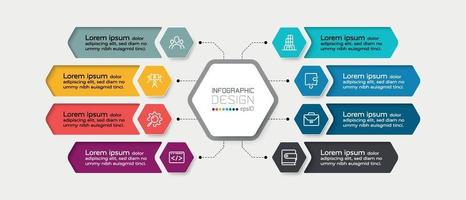
Infographic marketing holds immense potential for businesses seeking innovative strategies. In this guide, we present a comprehensive 7-step process to create impactful infographics, from understanding your audience to measuring success.
Discover how to revolutionize your marketing approach, leverage partnerships, and optimize your content for maximum reach.
Embrace the power of visual storytelling to engage your audience and drive your business forward.
Understanding Your Target Audience: The Foundation of Infographic Marketing
Commencing a successful infographic marketing strategy necessitates a comprehensive understanding of your target audience. This understanding is fostered through detailed audience segmentation, which involves dividing potential consumers into groups based on shared characteristics.
Knowledge of these segmentations can provide invaluable insights into consumer behavior, enabling the creation of an infographic that is not only visually appealing but also tailored to the needs and interests of your target demographic.
It is this strategic alignment of infographic content with consumer behavior that propels the success of an infographic marketing campaign. Innovatively designed infographics, deeply rooted in the understanding of your audience, can effectively capture attention, facilitate comprehension, and inspire action – the ultimate goal of any marketing strategy.
Developing a Compelling Infographic: The Design Process
Undeniably, the design process of an infographic is as crucial as its content, and it requires a strategic blend of creativity and data visualization techniques to yield a compelling output. This process begins with understanding color psychology, a strategic tool that uses hues to influence audience perception and behavior. Selection of colors should be in tune with the message you intend to convey.

The next critical step involves icon selection. Icons are visual elements that simplify complex information, engaging the viewer efficiently. The choice of icons should be intuitive and relevant to the data being showcased. Remember, the goal is to create an infographic that not only informs but also resonates with the viewer.
Hence, the design process should be a harmonious blend of strategic planning, creativity, and data presentation.
After you've successfully designed an engaging infographic, it's time to focus our attention on the crucial task of disseminating it effectively through the right promotion channels and employing the best SEO practices.
Social media sharing is an innovative and highly effective channel for promotion. Platforms like LinkedIn, Instagram, and Facebook can skyrocket your infographic's visibility and engagement. Consider Influencer collaboration as well; their large follower base can significantly boost your infographic's reach.
For SEO practices, ensure the infographic is included in your site map for easy crawling by search engines. Use descriptive file names and alt texts with your target keywords.
Leveraging Partnerships and Repurposing Content: A Fresh Approach to Infographic Marketing
A company's infographic marketing strategy can greatly benefit from leveraging partnerships and repurposing content, offering a fresh and efficient approach to enhance visibility and engagement.
Partnership Benefits: By collaborating with other companies or influencers, you can extend your reach and tap into new audiences. These partnerships often result in co-branded infographics that appeal to a wider demographic.

Content Recycling: Repurposing existing content into an infographic format can save time and resources. It also allows you to present your information in a novel, visually engaging way.
Innovation: This approach encourages creative thinking. By remixing old content and leveraging partnerships, you can keep your marketing strategy fresh and innovative.
The effectiveness of your infographic marketing strategy can be determined through the utilization of specific measurement metrics and infographic tools.
Metrics interpretation is vital to evaluate the impact of your infographics, such as tracking the number of views, shares, backlinks, and the amount of generated traffic. This data will provide a clear understanding of your infographic's performance, allowing you to adjust your strategy for optimal results.
Tool selection is another crucial aspect in this process. Innovative infographic tools offer robust analytics capabilities, helping you to gather and interpret crucial data. Choose a tool that aligns with your marketing objectives and has features such as real-time tracking and easy integration with other platforms.
This strategic approach will ensure your infographic marketing strategy's effectiveness and success.
Frequently Asked Questions
How Can I Integrate Infographic Marketing Into My Existing Marketing Strategy?
Integrating infographic marketing into your existing strategy involves incorporating Infographic SEO and targeted Infographic Distribution. This innovative approach enhances content visibility, user engagement, and effectively communicates complex data to your audience.

Can I Use Infographics in Email Marketing Campaigns?
Yes, infographics can significantly enhance email marketing campaigns. By leveraging infographic personalization, you create engaging content. Analyzing email analytics impact can further refine your strategy, driving increased engagement and conversion rates.
To effectively promote infographics on social media, strategic platform selection is vital. Tailor your content to the platform's audience. Additionally, content timing is key to maximize visibility and engagement for innovative infographic distribution.
The costs for creating and promoting an infographic can vary significantly, hinging on factors like budget planning and outsourcing expenses. It involves design costs, potential outsourcing charges, and expenses for promotion on chosen platforms.
Are There Any Specific Industries Where Infographic Marketing Is Particularly Effective?
Infographic marketing can be particularly effective across various industries, notably in healthcare and tourism. Infographics can distill complex health data and promote tourism destinations in an accessible, visually appealing manner, driving engagement and understanding.
 Digital Art InstructionDIY Infographics DesignMobile Game ArtworkPersonalized Logo Design3D AnimationeBook Covers DesignPrivacy PolicyTerms And Conditions
Digital Art InstructionDIY Infographics DesignMobile Game ArtworkPersonalized Logo Design3D AnimationeBook Covers DesignPrivacy PolicyTerms And Conditions
